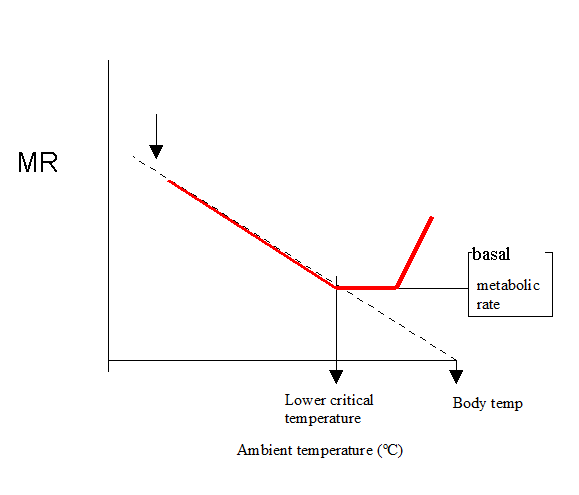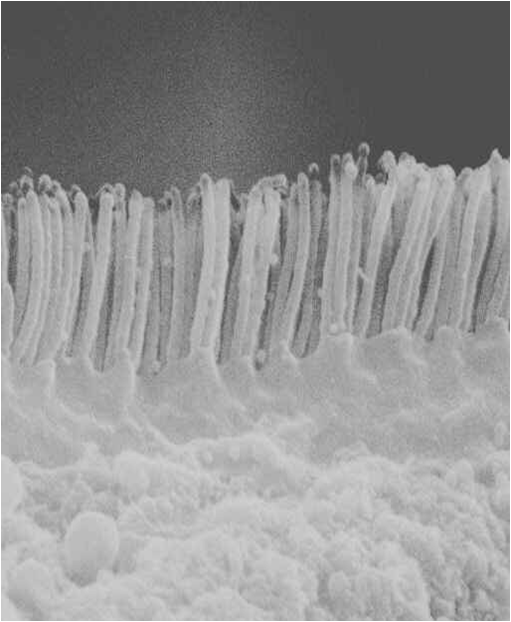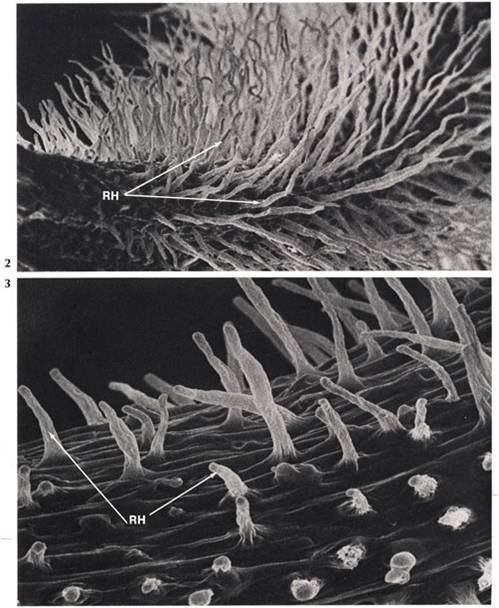General Biology, lecture on Nutrition, Digestion and Metabolism
VI. Nutrition
A. Functions of Nutrients in Plants and Animals
1. Energy
a. fuel glycolysis, Krebs cycle, and oxidative phosphorylation
b. Carbohydrates (C, H, O)
c. Fats
d. Proteins - deaminated
e. Ions (minerals): PO4 ð P for ATP
2. Structural Components
a. proteins: muscles, membranes (N)
i. 20 amino acids; the body can make 12 - the rest: diet
(animal products usually have all 20, plant products do not)
ii. plants require fixed N
(1) NH3 or NH4+ (ammon-ia -ium) or NO3- (nitrate)
b. carbohydrates: attached to membrane proteins
c. fats: adipose cells, membranes, nerve coatings (myelin)
d. Ions: Ca++: bone
3. Regulatory biochemicals
a. proteins: hormones (TSH, Insulin), neurotransmitters, receptors
i. TSH ð+ T4 ð regulates metabolism Ý
(TSH = thyroid stimulating hormone: T4 = thyroxine)
b. carbohydrates: attached to some protein regulatory biochemicals (TSH)
c. fats: steroid hormones
d. Ions: I-: thyroxine
i. from salt and seafood
4. Components of Physiological mechanisms
a. protein: muscle movement, membrane selectivity
b. Ions:
i. animal products (including milk): Ca++, Fe++
- Ca++: muscle movement, cell signalling
- Fe++: oxygen uptake (hemoglobin)
ii. plant products: P, Na+, K+, Cl-, Fe++, Zn++, Mg++, Ca++
- Na+: nerve signals
- K+: neural signals, H2O balance, stomata fxn
- Mg++: chlorophyll, cell signalling
iii. water: Fl-
c. vitamins: enzyme cofactors; combine to activate enzymes
i. e.g: Vitamin C is necessary for steroid metabolism
ii. Vitamin B12 is necessary for DNA synthesis
iii. Vitamin D is necessary for adding Ca++ to bone
iv. animal products: A, D, E, B1, B2, B6, Pantothenic acid,
Biotin, Nicotinamide, Folic acid, B12
v. plant products: A, E, K, B1, B2, B6, Pantothenic acid,
Biotin, Nicotinamide, Folic Acid, C
VII. Digestion
A. Anatomy
1. Mouth
2. Esophagus
3. Stomach
4. Small Intestine
a. doudenum
b. jejunum
c. ileum
5. Pancreas
6. Liver
7. Gall Bladder
8. Large Intestine
a. colon
b. rectum
9. Anus (sphincter)
B. Function (or follow a bolus of food)
1. Bite & mastication ð breaks up & mixes food with saliva (amylase)
a. amylase begins to breakdown carbohydrates into simple sugars
2. swallow & peristalsis move food to stomach
a. epiglottis protects the trachea
3. stomach: strong muscles churn food
a. HCl converts intestinal enzymes to break down proteins
b. makes lipase to work in the intestine
c. absorbs very little (water, salts, drugs, alcohol)
4. small intestine: major site of absorption
a. microvilli ñ surface area ðñ absorption
i. plant root hairs & mycorrhizae serve a similar function
b. only small molecules are absorbed
c. food stimulates hormone production
i. gastrin stimulates gastric (stomach) glands
ii. stretching ð neural reflex ð peristalsis
1) moves food bolus toward the large intestine
d. acid stimulates hormones (secretin and enterocrinin)
i. stimulate pancreas, liver, and intestinal glands
e. acid + fat stimulates cholecystokinin (CCK; a hormone)
i. CCK stimulates pancreatic juice
+ contracts the gall bladder ð bile
1) liver makes bile ð stores it in the gall bladder
f. bile breaks down fat
g. intestinal glands produce enzymes: breakdown sugars & proteins
h. pancreatic juice (in small intestines) buffers acid
has enzymes ð breakdown sugar, fat, and peptides
i. pancreas makes 2 homones (released into blood)
1) insulin: makes liver + other cells absorb sugar
ðò blood sugar
2) glucagon: liver releases sugar into blood
ðñ blood sugar
i. capillaries surround the intestines
i. absorption occurs through microvilli
1) and their cells
2) and into capillaries
j. capillaries feed to Hepatic (=liver) Portal vein
i. portal system = 2 capillary beds with veins but no heart in between
ii. atery ð capillary ð portal vein ð capillary ð vein ð heart
k. hepatic portal vein ð liver
5. Liver: common capillary sinus
a. from portal vein (bringing food) + hepatic artery (bringing O2)
b. liver synthesizes proteins
c. removes and detoxifies poisons (alcohol)
d. stores sugar, fat, vitamins, minerals
6. At the point where the small intestine meets the colon is the appendix
a. a very large Peyer's patch (Lymph node)
b. is involved in protein digestion in rabbits
7. Most of the H2O in food is absorbed at the rectum
C. Digestive Adaptation
1. Ruminants
a. rumen = extra stomach chamber
i. filled with bacteria & protists to digest cellulose
2. Plant Symbioses and Carnivory
a. myco(fungus)rrhizae(root) and rhizobia (bacterial root nodules) symbioses
i. increase absorption + fixed N
b. cynaobacteria and actinobacteria fix N
c. carnivorous plants get N from animal proteins
3. Gizzard
a. some birds: specialized portion of the esophagus/stomach
i. contains small rocks
1) makes up for a lack of teeth
4. Cecum & coprophagy
a. rabbits: blind sac where small/large intestine meet
i. contains microorganisms
ii. plant materials are broken down more
iii. fecal material must be re-eaten
1) to absorb newly available proteins & sugars
2) only possible in the duodenum
iii. 2nd time fecal pellets are not eaten
5. Long intestinal tracts
a. allow herbivores to extract more from their food
b. carnivores have short digestive tracts
VIII. Metabolism
A. Breaking down (catabolism) or building (anabolism) bodily constituents
B. The sum of all metabolic processes and the energy it takes to do it
1. less than half of food energy is converted into ATP bonds
a. most is released as heat
2. metabolic rate is the rate at which energy is utilized
a. may also be measured by the rate a body loses heat
i. large bodied animals use less energy/g body mass
than small animals
C. Homeotherms: Basal Metabolic Rate
1. minimum metabolic rate - at rest, at optimum ambient To
 2. Homeotherms- capable of maintaining constant Tobody below optimum Tao
a. by producing heat endothermically
b. Tob saved by pelage adjustments
i. or countercurrent heat exchange
3. maintaining constant Tob above BMR-upper critical Tao by sweating or panting
4. at even higher Tao metabolism is controlled by Tao as it is in Poikilotherms
a. Q10 effect = for every 10oC Tao ð 2x MR
2. Homeotherms- capable of maintaining constant Tobody below optimum Tao
a. by producing heat endothermically
b. Tob saved by pelage adjustments
i. or countercurrent heat exchange
3. maintaining constant Tob above BMR-upper critical Tao by sweating or panting
4. at even higher Tao metabolism is controlled by Tao as it is in Poikilotherms
a. Q10 effect = for every 10oC Tao ð 2x MR
D. Poikilotherms (ectotherms) make heat by metabolism
1. but...their MR (metabolic rate) is much lower
a. Q10 effect ðñ MR
i. ñ10oC ðñ 2 x MR
ii. ñ20oC ðñ 4 x MR
2. \ most Tbo must come ectothermically
a. through behavioral adaptations like basking
b. providing the ñTao for Q10 effect ðñ MR

